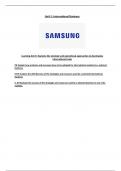Exam (elaborations)
IB HL Physics Paper 1 Worked Solutions with Complete IA Guide and Sample IA and EE
- Institution
- International Baccalaureate
A must-have for all HL IB Physics Students. Complete, fully explained solutions for every paper 1 HL question from every released paper from the current syllabus (all seasons and time-zones from the new syllabus, including 2019) covering over 420 questions. This book is written by three IB graduate...
[Show more]







